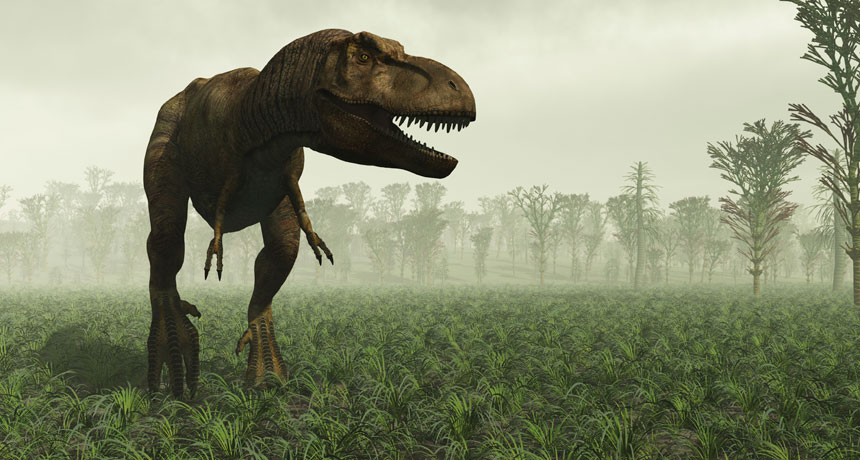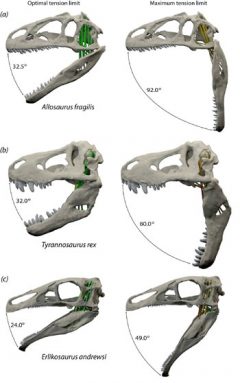Predatory dinos were truly big-mouths
New study estimates T. rex and Allosaurus opened very wide to bite into prey

T. rex’s choppers were the size of bananas. That meant it had to open its mouth plenty wide, a new study finds — or risk starvation.
JoeLena/iStockphoto
Share this:
- Share via email (Opens in new window) Email
- Click to share on Facebook (Opens in new window) Facebook
- Click to share on X (Opens in new window) X
- Click to share on Pinterest (Opens in new window) Pinterest
- Click to share on Reddit (Opens in new window) Reddit
- Share to Google Classroom (Opens in new window) Google Classroom
- Click to print (Opens in new window) Print
By Sid Perkins
Many dinosaurs are known for their fearsome teeth. Allosaurus had sharp, bladelike choppers. Many were 5 to 10 centimeters (2 to 4 inches) long. Tyrannosaurus rex had bigger ones — the size of bananas. Big teeth are a plus for a predator. But unless a creature can open its mouth very wide, long teeth might actually be a good recipe for starvation. Many big-toothed species survived for millions of years, though. And that is because their jaws could open plenty wide, the better to latch on to big prey, a new study finds.
Paleontologists can easily measure the size of a fossil tooth. But figuring out how far a dinosaur could open its jaws is trickier. That’s because fossils rarely preserve the soft tissues that once held bones together — and set limits on their movement. Now, a researcher has come up with a way to estimate how widely a dino could open its jaws. This is known as a “gape angle.”
Stephan Lautenschlager is a biomechanicist (BI-oh-meh-KAN-ih-cizt). Such scientists study how living things move. At the University of Bristol in England, he’s been working out how widely some dinosaurs could stretch open their mouths to feed (or maybe yawn!). In his new study, he looked at theropods. Most theropod species were meat-eaters.
Allosaurus fragilis was a fierce, towering predator that roamed the Earth between 150 million and 155 million years ago. The better-known T. rex lived more recently, just 66 million to 69 million years ago. Both were top predators in their environments. The third species was Erlikosaurus andrewsi. It lived around 90 million years ago. E. andrewsi also was a theropod, but it had small teeth and was probably an herbivore, or plant-eater.
Lautenschlager used pictures and 3-D scans of well-preserved fossils to create computer models of the three dinos’ jaws. In particular, he was interested in the dozen or more areas where muscles or tendons attached to the skull and lower jaw.
Next, he linked the skull and jaw in each model with simulated muscles. Unlike real muscles, the virtual ones in the computer model were simple cylinders. They could stretch from one point on the skull to another point on the jaw. Little direct information exists on dinosaur muscles, so Lautenschlager used data that had been gleaned from birds and crocodiles. These creatures are among dinosaurs’ closest living relatives.
Studies of these relatives suggest that the muscles exert their greatest force when they are stretched about 30 percent longer than their resting length. In other words, if a relaxed muscle is 10 centimeters (4 inches) long, it pulls with maximum force when it is stretched to a length of 13 centimeters (5.1 inches). Also, a muscle typically can’t pull at all if it is stretched to 170 percent of its resting length, says Lautenschlager. Beyond that, a muscle can rip or be damaged in some other way.

For his computer models, Lautenschlager assumed the angle between the upper and lower jaw was between 3 and 6 degrees. (For comparison, the right angle at each corner of a square is equal to 90 degrees.) According to the new computer analyses, T. rex could stretch its mouth open as much as 80 degrees (almost as wide as the corner of a square). But it would exert its largest bite force when the lower jaw was not extended quite so far — just 32 degrees. That’s a little less than halfway open, but it is still plenty wide enough to latch onto large prey.
Similarly, A. fragilis had its strongest bite with a gape angle of 32.5 degrees. But the new analysis find this dino could open its mouth a whopping 92 degrees. That’s more than a right angle!
In contrast, E. andrewsi could open its jaws, at most, about 49 degrees, the new analysis suggests. That helps bolster the idea that this dinosaur was a plant eater, Lautenschlager notes. “You don’t need a wide gape to grab leaves.”
He reported his results November 4 in the journal Royal Society Open Science.
“This is innovative research,” says Lawrence Witmer. He’s a paleontologist at Ohio University in Athens. Only within the past 5 years or so have paleontologists had the computer-modeling capability to do such analyses, he points out. The next step, he says, would be to include more realistically shaped muscles in those simulations.
Thomas Holtz Jr. is a paleontologist at the University of Maryland in College Park. He agrees that the new study “shows the power of computer modeling in understanding animals both living and dead.” It’s especially useful, he adds, for helping scientists figure out the feeding behaviors of ancient creatures.
Power Words
(for more about Power Words, click here)
allosaurs (also known as allosauroids) A group of two-legged, meat-eating dinosaurs named for one of its oldest species, Allosaurus.
Allosaurus fragilis A large predatory dinosaur that moved around on two legs. It lived in the later Jurassic Period, some 155 million years ago. With a body that spanned 7 to 10 meters (25 to 35 feet) long and likely moved faster than anything it preyed upon. In contrast to other predators in its environment, it had powerful arms with large-clawed hands.
angle The space (usually measured in degrees) between two intersecting lines or surfaces at or close to the point where they meet.
behavior The way a person or other organism acts towards others, or conducts itself.
biomechanics The study of how living things move, especially of the forces exerted by muscles and gravity on the skeletal structure.
biomechanicist A scientist who studies how living things move. For humans or other large animals, this might involve analyzing the forces exerted by muscles, tendons and gravity on an individual’s skeletal (or other supporting) structures.
computer model A program that runs on a computer that creates a model, or simulation, of a real-world feature, phenomenon or event.
dinosaur A term that means terrible lizard. These ancient reptiles lived from about 250 million years ago to roughly 65 million years ago. All descended from egg-laying reptiles known as archosaurs. Their descendants eventually split into two lines. They are distinguished by their hips. The lizard-hipped line became saurichians, such as two-footed theropods like T. rex and the lumbering four-footed Apatosaurus. A second line of so-called bird-hipped, or ornithischian dinosaurs, led to a widely differing group of animals that included the stegosaurs and duckbilled dinosaurs.
environment The sum of all of the things that exist around some organism or the process and the condition those things create for that organism or process. Environment may refer to the weather and ecosystem in which some animal lives, or, perhaps, the temperature, humidity and placement of components in some electronics system or product.
fossil Any preserved remains or traces of ancient life. There are many different types of fossils: The bones and other body parts of dinosaurs are called “body fossils.” Things like footprints are called “trace fossils.” Even specimens of dinosaur poop are fossils. The process of forming fossils is called fossilization.
gape (verb) To open the mouth wide. (noun) A wide opening or gap. In zoology, the width of the open mouth.
gape angle The angle between a creature’s upper and lower jaws.
herbivore A creature that either exclusively or primarily eats plants.
paleobiology The study of organisms that lived in ancient times — especially geologically ancient periods, such as the dinosaur era.
paleontologist A scientist who specializes in studying fossils, the remains of ancient organisms.
paleontology The branch of science concerned with ancient, fossilized animals and plants.
predator (adjective: predatory) A creature that preys on other animals for most or all of its food.
prey (n.) Animal species eaten by others. (v.) To attack and eat another species.
right angle A 90-degree angle, equivalent to any inside corner on a square.
simulate To deceive in some way by imitating the form or function of something. A simulated dietary fat, for instance, may deceive the mouth that it has tasted a real fat because it has the same feel on the tongue — without having any calories. A simulated sense of touch may fool the brain into thinking a finger has touched something even though a hand may no longer exists and has been replaced by a synthetic limb. (in computing) To try and imitate the conditions, functions or appearance of something. Computer programs that do this are referred to as simulations.
tendon A tissue in the body that connects muscle and bone.
theropod A usually meat-eating dinosaur that belonged to a group whose members are typically bipedal (walk on two legs). They range from small and delicately built to very large.
Tyrannosaurus rex A top-predator dinosaur that roamed Earth during the late Cretaceous period. Adults could be 12 meters (40 feet) long.
virtual Being almost like something. An object or concept that is virtually real would be almost true or real — but not quite. The term often is used to refer to something that has been modeled — by or accomplished by — a computer using numbers, not by using real-world parts. So a virtual motor would be one that could be seen on a computer screen and tested by computer programming (but it wouldn’t be a three-dimensional device made from metal).







